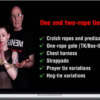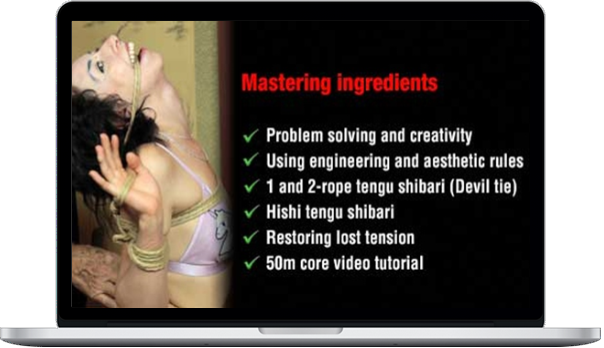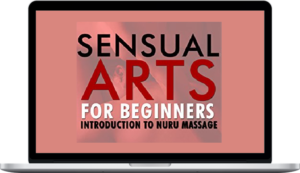Bruce Esinem – Mastering Ingredients
$23.80 $12.00
»Delivery: Within 21 days
Description
Bruce Esinem – Mastering Ingredients
Descrition Of Mastering Ingredients
Understanding the ingredients of shibari to tie with confidence, competence and passion
This tutorial will teach you how to master the ‘ingredients’ of shibari, i.e. the components that are used, to create your own ‘recipes’ (ties).The objective is not simply to teach a tie but how to create ties. Teaching ‘ingredients’ that make up the ‘recipes’ and how they can be varied and substituted has been extremely well-received as it makes sense of and simplifies what seems like a very complex subject. Expect that ‘lightbulb moment’ as it all becomes clear.
In reality, almost all ties are a combination of simple ingredients used according to a few basic rules. Once this is secret is grasped, you are freed from simply ‘painting by numbers’ to become both more creative and safer due to this understanding. This will be the most practical demonstration of this way of teaching that we have produced so far. In this example, how to tie tengu shibari, the ‘devil tie’, so-called because the arm position resembles wings…or, less romantically, an oven-ready chicken. Whatever you call it, it creates a nice exposed position that excentuates helplessness.
You explore various solutions and compare the methods of reaching them, discovering the pro’s and con’s.We teach you not just the tie but also the ‘why’. The solutions will, of course, be determined by intent and purpose. Something that is all too often not considered. In other words, the construction will vary, at one end of the scale, from a quick and dirty solution to a carefully engineered suspension tie or an art piece for a photograph at the other. It is, as they say, horses for courses. Not only does the tie need to fit the person, not vice versa, but it also needs to fit the situation and purpose.
Shibari is about much more than simply trotting out set patterns. This tutorial will give you the independance of creating your own ties, the ability to exert your individuality and make the experience of being tied intensely personal.
What You’ll Learn In Mastering Ingredients
This tutorial includes:
- One-rope single column based tengu shibari
- One-rope double column based tengu shibari
- Multiple starting points
- Two-rope tengu shibari chest harness
- Two-rope hishi (diamond pattern) tengu shibari
- Numerous tips and tricks, e.g. curing lost tension, effortless control techniques
Course Curriculum
Mastering Ingredients
- An introduction to ‘Mastering Ingredients’ (3:23)
- Safety (2:07)
- One-rope tengu based exercises (21:43)
- Two-rope tengu based exercises (15:40)
- Hishi tengu based exercises (9:21)
About Bruce Esinem
Esinem is a shibari artist who has regularly appeared at UK and international events such as Pride, Torture Garden, Erotica, Rubber Ball, Wasteland, Boundcon, Nuit Demonia and recently represented the UK at Japan’s first international kinbaku event, Toubaku. He is also known for his teaching both in the UK and internationally and was co-organiser of the London Festival of the Art of Japanese Bondage and BOUND, Europe’s premier monthly shibari event.
Over the years, he has been improving his skills with the help some of their best known and respected Jpanese kinbakushi, Arisue Go, Osada Steve, Kinoko Hajime, Kazami Ranki and, grand master of newaza, Yukimura Haruki. Whilst drawing from classical methods, his style is distinctive and epitomizes the art of communicating with rope, often departing from the typical serenity of shibari shows and flying in the face of tradition to produce some striking and unusual performances.
In addition, he has worked on various videos, e.g. Primal Scream’s 2013, artistic collaborations and photo shoots both on and off camera. He has been involved in projects providing inspiration for Tom Ford’s 2013 collection and, Raqib Shaw, an acclaimed artist who has exhibited at the Tate, Metropolitan and White Cube galleries.
He contributed to Rope, Bondage & Power, edited by Lee Harrington and has been involved with a number of documentaries on kinbaku. He is also author of the first English language tutorial DVDs: ‘Japanese Rope Bondage: Tying people, not parcels’ .
More courses from the same author: Bruce Esinem
Delivery Policy
When will I receive my course?
You will receive a link to download your course immediately or within 1 to 21 days. It depends on the product you buy, so please read the short description of the product carefully before making a purchase.
How is my course delivered?
We share courses through Google Drive, so once your order is complete, you'll receive an invitation to view the course in your email.
To avoid any delay in delivery, please provide a Google mail and enter your email address correctly in the Checkout Page.
In case you submit a wrong email address, please contact us to resend the course to the correct email.
How do I check status of my order?
Please log in to DatingCourse account then go to Order Page. You will find all your orders includes number, date, status and total price.
If the status is Processing: Your course is being uploaded. Please be patient and wait for us to complete your order. If your order has multiple courses and one of them has not been updated with the download link, the status of the order is also Processing.
If the status is Completed: Your course is ready for immediate download. Click "VIEW" to view details and download the course.
Where can I find my course?
Once your order is complete, a link to download the course will automatically be sent to your email.
You can also get the download link by logging into your DatingCourse account then going to Downloads Page.
You may also like:
- See more 2 Girls Teach Sex courses
- See more 60 Years of Challenge courses
- See more Adam Armstrong courses
- See more Adam Gilad courses
- See more Adam Lyons courses
- See more Arash Dibazar courses
- See more Bobby Rio courses
- See more Carlos Xuma courses
- See more David Deangelo courses
- See more David Shade courses
- See more David Snyder courses
- See more David Tian courses
- See more David Wygant courses
- See more Dean Cortez courses
- See more Derek Rake courses
- See more FortWorthPlayboy courses
- See more Gabrielle Moore courses
- See more Helena Nista courses
- See more James Marshall courses
- See more Jason Capital courses
- See more Jean Marie Corda courses
- See more Joe Lampton courses
- See more Jon Sinn courses
- See more Lloyd Lester courses
- See more Love Systems courses
- See more Marisa Peer courses
- See more Matt Cook courses
- See more Matt Granger courses
- See more Nick Krauser courses
- See more Pleasure Mechanics courses
- See more Ross Jeffries courses
- See more Talmadge Harper courses
- See more The Modern Man courses
- See more Tom Torero courses
Related products
Total sold: 3









